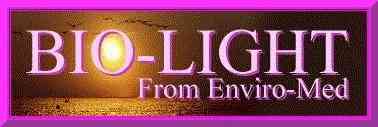 |
Enviro-Med 1600 S.E. 141st Ave. Vancouver, WA 98683 800-222-DAWN 800-222-3296 360-256-6989 |
|---|
| Contents: |
WINTER DEPRESSION DIAGNOSISAND TREATMENT PROTOCOL |
|---|---|
Researchers estimate 10-20% of the population suffers from Winter Depression (Seasonal Affective Disorder, or SAD), with incidence increasing in northern latitudes due to short winter days. Patients suffer recurrent episodes each winter with remission in spring. More women, from puberty until menopause , suffer from SAD than men. Approximately 80% of SAD patients respond to bright light therapy and it is considered to be the treatment of choice according to JAMA . Therapeutic light boxes emit light intensity 50 -100 times brighter than normal room light, without ultra violet rays. A minimum 2,500 lux is required for treatment, but 10,000 lux allows shorter treatment times. A trial of light therapy with a resultant remission of symptoms can be used to verify diagnosis. Symptoms:
• Vegetative: Hypersomnia, difficulty waking, morning grogginess, daytime fatigue, increased appetite with carbohydrate cravings and weight gain.
• Behavioral: Decreased libido, social withdrawal, decreased work productivity.
• Cognitive: Difficulty concentrating
• Affective: Dysphoria
• Atypical symptoms: hypersomnia and hyperphagia are most prevalent. Phase type the patient to determine what time of day to schedule light exposure. If the patient is groggy in the morning with difficulty feeling alert until later in the day, they are phase delayed, or ?night owls.? Often, but not always, they stay up late. They need morning light treatment. The majority of winter depressives are phase delayed, as are many teens. A minority of patients, often the elderly, are ?morning larks,? wakening in early predawn hours alert and energetic and becoming sleepy by early evening. They are phase advanced, use evening light.
Treatment Guidelines for Patients with Seasonal Affective Disorder
• Use light box each morning, immediately upon awakening, preferably no later than 8 AM. Ideally the light treatment should begin the same time each day with no delay on weekends. Patients should avoid bright light in the evening.
• Face the light box directly or at a 45° angle so light enters the eyes and hits the retina. Only periodic glancing at the light is necessary, staring is not needed. Patients may engage in activities such as reading, watching television, eating or exercising.
• Schedule 30 - 60 minutes with a 10,000 lux light box; or 1-2 hours at 2,500 lux. Lux levels are distance dependent, consult manufacturers lux chart to determine how far patient should be from fixture. Older patients sometimes find 2,500 lux more comfortable and can accomadate the longer treatment times. Some physicians start patients at 10,000 lux for 30 minutes at 2 weeks and if there is no response, increase to 1 hour, others start everyone at 1 hour to ensure response.
• The response begins 2 - 4 days after beginning light therapy and is usually complete within 2 weeks. Patients respond quicker and experience more complete remission of symptoms when treatment begins in early fall. Those starting in late winter may require longer treatment time initially.
• Maintain regular treatment schedule for the first 2 weeks. If patients do not respond to treatment they may need a longer duration to achieve a response. For example, if no response using 10,000 lux for 30 minutes, increase to 1 hour.
• If there is no response to morning light, a trial of evening light (7-9 PM) may be necessary. These patients should minimize any delay in their sleep time and should avoid bright light in the morning.
• After a complete response has been achieved, the duration and frequency of light exposures can be reduced. Maintenance schedules can be as little as 15-30 minutes daily, or even every other day.
• If patient begins awakening too early or becomes overly fatigued in the early evening, they may be overly phase advanced due to too much morning light. Reduce the duration or intensity of light, or a little evening light can be added.
• Patients with retinal problems, or those taking photosensitizing drugs should be referred for an eye exam.
Available Assessment Tools?Clinician rating guides for Winter Depression - SAD/Seasonality :
Seasonal Pattern Assessment Questionnaire (Rosenthal, Bradt, & Wehr, 1984) screening instrument with good empirical validity for predicting seasonality
Structured Interview Guide for the Hamilton Depression Rating Scale-Seasonal Affective Disorder Version (SIGH-SAD)
DSMIV-296.3X Refer to ?Seasonal Pattern Specifier? |
|
Back to Articles |
[Contents] [Home] [Therapy] [Lights] [Order] [Articles] [About] [Feedback] [Site Map] DISCLAIMER: Enviro-Med cannot offer medical advice or recommend which individuals should receive light therapy for seasonal affective disorder, winter blues or other conditions. We advise that light therapy for seasonal affective disorder or other conditions be prescribed by a physician or other qualified health care professional and duration and timing supervised by the same. Consult with your physician to rule out any ophthalmological or other conditions that might preclude the use of light therapy. Copyright © 1997 Enviro-Med, http://www.BIO-LIGHT.com/ MAILTO:Bio-Light@Bio-Light.com
|